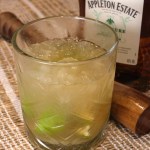

A tale of two rums.
Double rum review: Blackwell and Worthy Park 109.
What’s better than a rum review? Two rum reviews! And betterer still Jamaican rum reviews! Nope, we don’t do things by halves on the good ship Proof me hearties.
At first glance these might be mistaken for similar products – both are dark Jamaican rums after all – but upon closer examination we find them to be very different beasts. How so? Read on, dear reader, read on!
Blackwell Black Gold Special Reserve.
Straight away I’m gonna drop the descriptors and just call this Blackwell’s like everyone else does as there is no other variant of it beside the cheesy 007 branded bottle (rolls eyes). Blackwell’s is supposedly the secret family recipe of famous Jamaican record producer Chris Blackwell but I’m wary of this kind of blurb that we find on the rear of the bottle as it often amounts to little more than an iffy attempt at whipping up some historical mumbo-jumbo to shift product. It may or may not be true but I’d much prefer some solid facts about how the rum is produced. Hence I was reluctant to try this rum for a time seeing it as bordering on one of those “rock” branded spirits such as AC/DC Thunderstruck tequila or Motörhead rum (rolls eyes again). I think this branding may have done more harm than good but I’m way off track now and need to reboot this review.
Blackwell comes in a straightforward 700ml brown glass bottle with a metal screw cap. The label is quite nicely done being all deliberately misaligned and with a distinct “piratey” aesthetic. The seal on the side is a nice touch but aside from that it is a pretty uninteresting bottling for the price. The marketing jibber-jabber aside there is zero useful information beyond the compulsory 40% ABV statement (the website provides nothing more concrete either). No indication of age. Pot or column? Who knows? Who’s making this for Chris? Does he even know? If he does he’s not telling! I’ve gotta be honest; the signs are not encouraging. Undeterred* I pour a measure. I was expecting something much darker (a reason I dislike coloured bottles) than the coppery liquid that hits my glass. Everything I’ve seen was signaling a black rum but this is a few shades short of such. OK, let’s have a sniff. Damn, but this smells lovely with distinct caramel and vanilla fragrances and a little spice in the background. When tasted we get pretty much what we smelled as well as a smooth and buttery texture with little burn. It’s really quite decent for something with so little providence. While you could definitely sip this I bought it with mixing in mind and as a possible replacement for Myers’s in my Zombies and the like. I don’t hate Myers’s like some folks do but I always had the feeling I could do a little better. Lo and behold subbing Blackwell’s into my Zombie made a noticeable improvement to the point I would stock it for that purpose alone. Furthermore I found Blackwell’s a pleasing rum as a component of a Mai Tai. Well, I’m still a little shocked that this rum had anything under the hood at all let alone that it would be a permanent fixture on the Proof bar. It’s a tad pricey in my parts at around €28 but largely for it’s excellent mixability I’ve got to award it an:
A-
Worthy Park 109.
It turns out Worthy Park 109 is the polar opposite of Blackwell’s with providence coming out of its ears. One of Jamaica’s most ancient and revered distilleries whose juice often finds its way into special bottlings for other brands the Worthy Park name immediately caught my attention. The other attention grabber is that 109 on the label. Yup, that’s 109 proof better known as 54.5% ABV or the revised Navy Proof of the British Navy. At €32.50 for a litre at such a high strength this looks like pretty fine value for a rum from such a prestigious distiller. Furthermore we have an ocean of useful information on the production. Right up front on the simple but tasteful label we read The Magic Words “100% copper pot distilled”. I’m in! There are more details but the most relevant is that it is a blend of their own aged and un-aged rums and that everything is done in-house. But enough, let’s get to it.
Poured from the large clear (smiles) bottle which in itself is satisfactory if dull we see the expected deep mahogany colour. Clearly it’s a caramel coloured rum then but, hey, that’s what makes a dark rum dark**. The first sniff is pretty unforgiving. Ethanol hits first in a pretty brutal way but as it subsides we get a nice treacly impression with dark roast coffee in the background. The taste is similar: treacle scones at halloween accompanied by a sip of bitter espresso. There are raisin and spice flavours in there too and no sweetness to be found. This is grown up rum and certainly not for beginners. The finish is long and warming but the alcohol doesn’t hide its presence and this is certainly not a rum I’m going to be sipping on. I can see a sailor downing one after a cold, hard shift but that’s little help to us cocktailistas. I really wanted to like this rum and I kinda do. But. The problem is that there are other better rums in this zone. For a Navy rum it can’t supplant Wood’s and for an overproof demerara stand-in it can’t touch Plantation OFTD. I tried it in a number of cocktails and it just wasn’t a rum that plays nice with others as its bitter notes seem to dominate and take over the drink. I still think I might find something interesting to do with it but for now I can’t recommend it as a flexible mixing rum – and if it’s not a sipping rum where does that leave it? It leaves it with a:
B.
Note on sugar/sweetness.
I tested both of these rums for added sugar and neither had any significant dosing. Unsurprising as Jamaican rum pretty much never does. There are differences in perceived sweetness but it is just that a perception based on the flavours present. Blackwell tastes sweeter due to the vanilla notes and WP109 somewhat bitter due to the coffee notes is my best guess. Similarly Myers’s tastes sweet due to the molasses flavours yet also tests negative for added sugar.
Conclusion.
Don’t judge a book by its cover folks. Labels with production details usually help us a lot but here we a clear case where they didn’t and it shows that there is no substitute for tasting.
*OK somewhat deterred.
**Yeah, it’s rarely got anything to do with ageing in barrels at this price or below.
xxx Update xxx
I knew I’d find a use for WP109 sooner or later. I now use it as a key component of my home blended dark Jamaican rum.





























Recent Comments